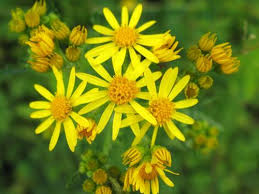There are many poisonous plants. Animals avoid them usually spontaneously, at least if they have sufficient other offer. So do not leave them standing on a bare pasture.
By drying grass clippings or silaging as winter feed is a lot of present poison neutralized. But not the (tansy) ragwort (Senecio jacobaea), which remains toxic.
 If horses or cattle eat it, the toxins accumulate in the liver (cirrhosis).
If horses or cattle eat it, the toxins accumulate in the liver (cirrhosis).
The plant contains sixteen different alkaloids. All plant parts are poisonous.
After a cumulative consumption of 3-7% of the body weight the animal dies within a few weeks to months.
The syndrome may include lethargy, weight loss, diarrhea, lack of appetite, excessive drinking and sunburn.
An antidote does not exist, it is impossible to cure.
When spraying or mowing the dead plant remains toxic (and is sometimes -even cut – still producing seeds!). All residues must therefore be removed. Thus you can better stab them with the root and burn. Wear gloves because she is also toxic to humans.
The orange black striped zebra caterpillar, the larva of the cinnabar moth (Tyria jacobaea, a diurnal moth) is not susceptible to poisoning by pyrrolizidine alkaloids. She can eat the plant bare, but she shoots again.
The plant resembles tansy, but has yellow ray flowers (petals) and a yellow center. Ragwort has kale -like single or double feather parted, not hairy and scattered leaves (with a double cut of the blade edge, one perpendicular to the grain, and one perpendicular to that incision.)
On the ground, the plant has a root rosette. After 1 or several years, the plant forms a strong branched, green red, tough stems with screen -shaped panicles of yellow flowers.
After flowering from June to August, tens of thousands of seeds as a silver-gray fluff are spread.
Poisonous plants are not for all species equally toxic.
Sheep like to eat ragwort and are less sensitive to the consequences. They later get, however, problems in growth. The herb is only deadly to sheep when they eat more than 300 percent of their body weight in dried ragwort. Practice from abroad showed that winter grazing with sheep can prevent expanding the herb.
Maple seeds and shoots are toxic to horses
St. John's wort (Hypericum perforatum), ragwort, buckwheat, red clover and hogweed (Heracleum sphondylium) bring in cattle substances in the blood that cause sunburn (Eczema solare) on sparse hairy, non-pigmented skin.
(Leaves and flower heads of red clover are edible for humans.)
What to a caterpillar is the end of the world,
is only the beginning to a butterfly.
